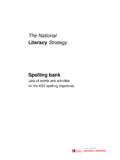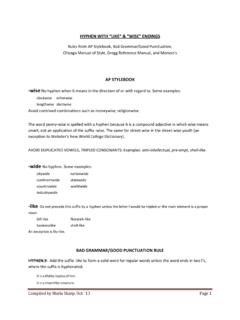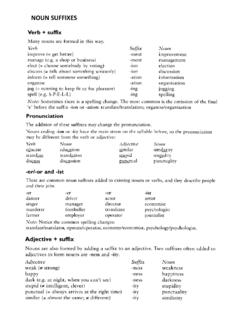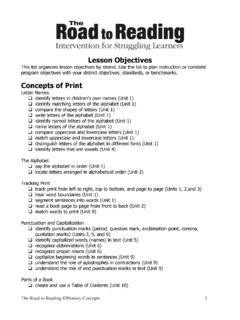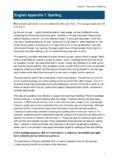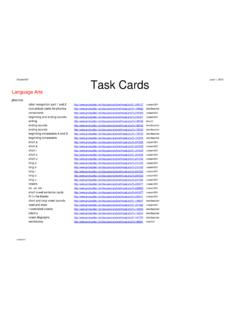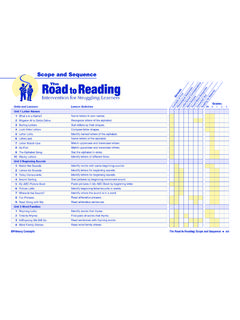Transcription of Autumn Term Spring Term Summer Term Spelling Words …
1 Autumn Term Spring Term Summer Term Spelling Transcription To spell further homophones. To spell Words that are often misspelt. (Appendix 1 ) To use further prefixes and suffixes and understand how to add them. To write from memory simple sentences, dictated by the teacher, that include Words and punctuation taught so far. Revising the prefixes un-, in-, dis- The short u sound spelt ou * (double, trouble, enough, toughest, rougher, young, country, touch Words with the s sound spelt sc Possessive apostrophes with plural Words * adding the prefix mis adding the prefix auto- Words ending zhun spelt sion Words ending in zhuh spelt sure adding the suffix ly (to adjectives to form adverbs) adding il- and revising un-, in-, mis-, dis- adding the prefix inter- The c sound spelt que and the g sound spelt gue Homphones* : groan/grown, main/mane, reign/rain/rein, peace/piece, berry/bury Homophones*.)
2 Heal/heel, missed/mist, who s/whose, accept/except, affect/effect Words with the ay sound spelt ei, eigh and ey adding ir- to Words beginning with r Words ending in -ous adding the suffix ion spelt -tion, -sion, -ssion, -cian Handwriting To use diagonal and horizontal strokes that are needed to join letters and understand which letters, when adjacent to one another, are best left unjoined. To increase legibility, consistency and quality of their handwriting. Ongoing across all terms Contexts for Writing Tobe able to discuss writing similar to that which they are planning to write in order to understand and learn from it s structure, vocabulary and grammar. Story writing, Poetry, Information text including ten minute writing opportunities. Explanantion, Journalistic Writing, Persuasive writing, Narrative - including ten minute writing opportunities.
3 Poetry nonsense, Narrative: imaginary worlds, Playscirpts, Stories from other cultures - including ten minute writing opportunities. Planning Writing To be able to discuss and record ideas. To be able to compose and rehearse sentences orally (including dialogue) progressively building a varied and rich vocabulary and an increasing range of sentence structures. Read and discuss exemplar texts to familiarise with structure, grammar and vocabulary. Read and discuss exemplar texts to familiarise with structure, grammar and vocabulary Read and discuss exemplar texts to familiarise with structure, grammar and vocabulary Identify and discuss features of structure vocabulary and grammar and similar writing: Story writing, Poetry, Information text identify and discuss features of structure vocabulary and grammar and similar writing: Explanantion, Journalistic Writing, Persuasive writing, Narrative Identify and discuss features of structure vocabulary and grammar and similar writing: Poetry nonsense, Narrative: imaginary worlds, Playscirpts, Stories from other cultures.
4 Plan writing including structure, vocabulary and grammar from objectives Plan writing including structure, vocabulary and grammar from objectives. Plan writing including structure, vocabulary and grammar from Drafting Writing To organise paragraphs around a theme. Story Mountains Mindmapping sequencing Story boarding Organising paragraphs through information texts Organising paragraphs through journalistic writing. Creating setting characters and plot Describe setting understanding how small details can be included to evoke time, place and mood drawing on this to demonstrate how characters behave. To create settings, characters and plot in narrative writing. To use simple organisational devices in non-narrative writing. Creating setting characters and plot Describe setting understanding how small details can be included to evoke time, place and mood drawing on this to demonstrate how characters behave.
5 Paragraphs Recognising that longer sections may require more than one paragraph. Signal sequence place and time to give coherence Paragraphs Use adverbs and conjunctions to establish cohesion. PARAGRAPHS group linked info into sections Non Narrative Paragraph, Headings simple organisational features, subheadings and labels and diagrams. To use dialogue to build character descriptions and evoke responses from the reader. Non Narrative Paragraph, Headings simple organisational features, subheadings and labels and diagrams. Record info researched from a number of different sources and reorganising into coherent paragraphs to create texts. To plan and write a story identifying intro, build up, climax and resolution. Record info researched from a number of different sources and reorganising into coherent paragraphs to create texts.
6 To plan and write a story identifying intro, build up, climax and resolution. Editing Writing To be able to assess the effectiveness of their own and other s writing and suggest improvements. To be able to propose changes to grammar and vocabulary to improve consistency, including the accurate use of Re-read, edit and improve (ongoing but taught specifically here) Re-read edit and improve suggesting appropriate improvements as necessary. Re-read edit and improve suggesting appropriate improvements as necessary. Re-read edit and improve suggesting appropriate improvements as necessary. Editing Checking verb tense agreement. Editing Checking speech demarcated by Editing checking commas are used to demarcate clauses. pronouns in sentences. To be able to proofread for Spelling and punctuation errors. Performing Writing To read their own writing aloud, to a group or whole class, using appropriate intonation, and controlling the tone and volume so that the meaning is clear.
7 To compose and rehearse orally Read aloud and respond appropriately to own writing. To compose and rehearse orally Read aloud and respond appropriately to own writing. To compose and rehearse orally Read aloud and respond appropriately to own writing. Vocabulary To extend the range of sentences with more than one clause by using a wider range of conjunctions, including when, if, because, although To be able to choose nouns or pronouns appropriately for clarity and cohesion and to avoid repetition Simile, Metaphors Expressive verbs, alliteration Idioms To use figurative and expressive language to build a fuller picture of character To use figurative and expressive language to build a fuller picture of character Punctuation To be able to use commas after fronted adverbials. To be able to indicate possession by using the possessive apostrophe with singular and plural nouns.
8 To be able to use and punctuate direct speech. Proof reading to support: Commas after fronted adverbials, commas in lists. Fullstops. Proof reading to support: comma after reporting clauses. Question marks. Proof reading to support: Direct speech, apostrophes for omissions, apostrophes marking singular possessions. Spelling errors (related to Spelling outcomes) Spelling errors (related to Spelling outcomes) Spelling errors (related to Spelling outcomes) Grammar To be able to use fronted adverbials. To be able to recognise the difference between plural and possessive s. To be able to use Standard English verb inflections. To be able to extend noun phrases, including with prepositions. To be able to make appropriate choices of pronouns and/or Fronted adverbials sentence structures manipulating clause types. Conjunctions and manipulating clause types cause and effect and sequencing when before, after, while, so , because , then , next , soon after.
9 Noun phrases expanded by addition of modifying adjectives, nouns and prepositional phrases. Expressing time, place and cause using adverbs and prepositions. Changes to grammar and vocabulary to improve pronouns and nouns to avoid repetition. Consistent use of tense. Appropriate choices for tense changes. nouns to create cohesion. Grammatical Terminology Fronted adverbials identify examples use across a range or writing, use comma after Pronouns Identify pronouns inreading. Inverted commas identify direct speech, punctuate direct speech, proof reading. Apostrophes to mark singular plural possession. Paragraphs Identify within paragraphs: key Words , main points, important information. Summarise key points. Identify how pronouns maintain flow Use pronouns in own writing.
